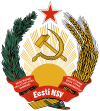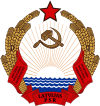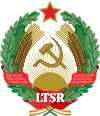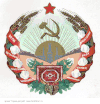
Belarus, officially the Republic of Belarus, is a landlocked country in Eastern Europe. It is bordered by Russia to the east and northeast, Ukraine to the south, Poland to the west, and Lithuania and Latvia to the northwest. Belarus spans an area of 207,600 square kilometres (80,200 sq mi) with a population of 9.1 million. The country has a hemiboreal climate and is administratively divided into six regions. Minsk is the capital and largest city; it is administered separately as a city with special status.

The Supreme Soviet of the Union of Soviet Socialist Republics (SSUSSR) was the highest body of state authority of the Soviet Union (USSR) from 1936 to 1991. Based on the principle of unified power, it was the only branch of government in the Soviet state.

The Commonwealth of Independent States (CIS) is a regional intergovernmental organization in Eurasia. It was formed following the dissolution of the Soviet Union in 1991. It covers an area of 20,368,759 km2 (7,864,422 sq mi) and has an estimated population of 246,200,194. The CIS encourages cooperation in economic, political, and military affairs and has certain powers relating to the coordination of trade, finance, lawmaking, and security, including cross-border crime prevention.

The Russian Communist Workers' Party of the Communist Party of the Soviet Union is an anti-revisionist Marxist–Leninist communist party in Russia. It is considered the republican branch of the Communist Party of the Soviet Union (2001).

The Ukrainian Soviet Socialist Republic, abbreviated as the Ukrainian SSR, UkSSR, and also known as Soviet Ukraine or just Ukraine, was one of the constituent republics of the Soviet Union from 1922 until 1991. Under the Soviet one-party model, the Ukrainian SSR was governed by the Communist Party of the Soviet Union through its republican branch, the Communist Party of Ukraine.
The 1936 Constitution of the Soviet Union, also known as the Stalin Constitution, was the constitution of the Soviet Union adopted on 5 December 1936.

The Russian Republic, referred to as the Russian Democratic Federal Republic in the 1918 Constitution, was a short-lived state which controlled, de jure, the territory of the former Russian Empire after its proclamation by the Russian Provisional Government on 1 September 1917 in a decree signed by Alexander Kerensky as Minister-Chairman and Alexander Zarudny as Minister of Justice.

The Presidium of the Supreme Soviet was the standing body of the highest body of state authority in the Union of Soviet Socialist Republics (USSR). The presidium was elected by joint session of both houses of the Supreme Soviet to act on its behalf while the Supreme Soviet was not in session. By the 1936 and 1977 Soviet Constitution, the Presidium of the Supreme Soviet served as the collective head of state of the USSR. In all its activities, the Presidium was accountable to the Supreme Soviet of the USSR.

The political system of the Soviet Union took place in a federal single-party soviet socialist republic framework which was characterized by the superior role of the Communist Party of the Soviet Union (CPSU), the only party permitted by the Constitution.

The State Security Committee of the Republic of Belarus is the national intelligence agency of Belarus. Along with its counterparts in Transnistria and South Ossetia, it kept the unreformed name after declaring independence.

The Revolutions of 1989, also known as the Fall of Communism, were a revolutionary wave of liberal democracy movements that resulted in the collapse of most Marxist–Leninist governments in the Eastern Bloc and other parts of the world. This revolutionary wave is sometimes referred to as the Autumn of Nations, a play on the term Spring of Nations that is sometimes used to describe the Revolutions of 1848 in Europe. The Revolutions of 1989 were a key factor in the dissolution of the Soviet Union—one of the two global superpowers—and in the abandonment of communist regimes in many parts of the world, some of which were violently overthrown. These events drastically altered the world's balance of power, marking the end of the Cold War and the beginning of the post-Cold War era.
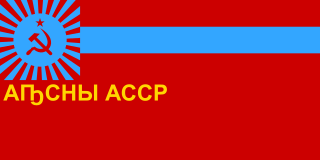
The Abkhaz Autonomous Soviet Socialist Republic, abbreviated as Abkhaz ASSR, was an autonomous republic of the Soviet Union within the Georgian SSR. It came into existence in February 1931, when the Socialist Soviet Republic of Abkhazia, originally created in March 1921, was transformed to the status of Autonomous Soviet Socialist Republic within the Georgian SSR.

This timeline lists the dates of the first women's suffrage in Muslim majority countries. Dates for the right to vote, suffrage, as distinct from the right to stand for election and hold office, are listed.

An independence referendum was held in the Republic of Georgia on 31 March 1991. It was approved by 99.5% of voters.

The Declaration "On the Restoration of Independence of the Republic of Latvia" was adopted on 4 May 1990 by the Supreme Soviet of the Latvian SSR in which Latvia declared independence from the Soviet Union. The Declaration stated that, although Latvia had de facto lost its independence in 1940, when it was annexed by the Soviet Union, the country had de jure remained a sovereign country as the annexation had been unconstitutional and against the will of the Latvian people.

The electoral system of the Soviet Union was varying over time, being based upon Chapter XIII of the provisional Fundamental Law of 1922, articles 9 and 10 of the 1924 Constitution and Chapter XI of the 1936 Constitution, with the electoral laws enacted in conformity with those. The Constitution and laws applied to elections in all Soviets, from the Supreme Soviet of the Soviet Union, the Union republics and autonomous republics, through to regions, districts and towns. Voting was claimed to be secret and direct with universal suffrage. However, in practice, between 1936 and 1989, voters could vote against candidates preselected by the Communist Party only by spoiling their ballots, or by voting against the only candidate, whereas votes for the party candidates could be cast simply by submitting a blank ballot. A person would be given a ballot by a clerk, and could immediately walk to the ballot box, and while there were booths in which one could strike the candidates they voted against off the ballot, this was easy to record and was not commonly done by voters.
Supreme Soviet elections were held in the Soviet Union on 12 December 1937. It was the first election held under the 1936 Soviet Constitution, which had formed the Supreme Soviet of the Soviet Union to replace the old legislature, the Congress of Soviets of the Soviet Union.

The Union of Soviet Socialist Republics (USSR) was formally dissolved as a sovereign state and subject of international law on 26 December 1991 by Declaration № 142-Н of the Soviet of the Republics of the Supreme Soviet of the Soviet Union. It also brought an end to the Soviet Union's federal government and General Secretary Mikhail Gorbachev's effort to reform the Soviet political and economic system in an attempt to stop a period of political stalemate and economic backslide. The Soviet Union had experienced internal stagnation and ethnic separatism. Although highly centralized until its final years, the country was made up of 15 top-level republics that served as the homelands for different ethnicities. By late 1991, amid a catastrophic political crisis, with several republics already departing the Union and Gorbachev continuing the waning of centralized power, the leaders of three of its founding members, the Russian, Belorussian, and Ukrainian SSRs, declared that the Soviet Union no longer existed. Eight more republics joined their declaration shortly thereafter. Gorbachev resigned on 25 December 1991 and what was left of the Soviet parliament voted to dissolve the union the following day.

The Soviet of Nationalities was the upper chamber of the Supreme Soviet of the Union of Soviet Socialist Republics, elected on the basis of universal, equal and direct suffrage in accordance with the principles of Soviet democracy. Until democratization in the late-1980s, however, only a single candidate nominated by the Communist Party of the Soviet Union was permitted to stand for election in each constituency. It was briefly succeeded by the Soviet of the Republics from October to December 1991. As opposed to the Soviet of the Union, the Soviet of Nationalities was composed of the nationalities of the Soviet Union, which in turn followed administrative division rather than being a representation of ethnic groups.


